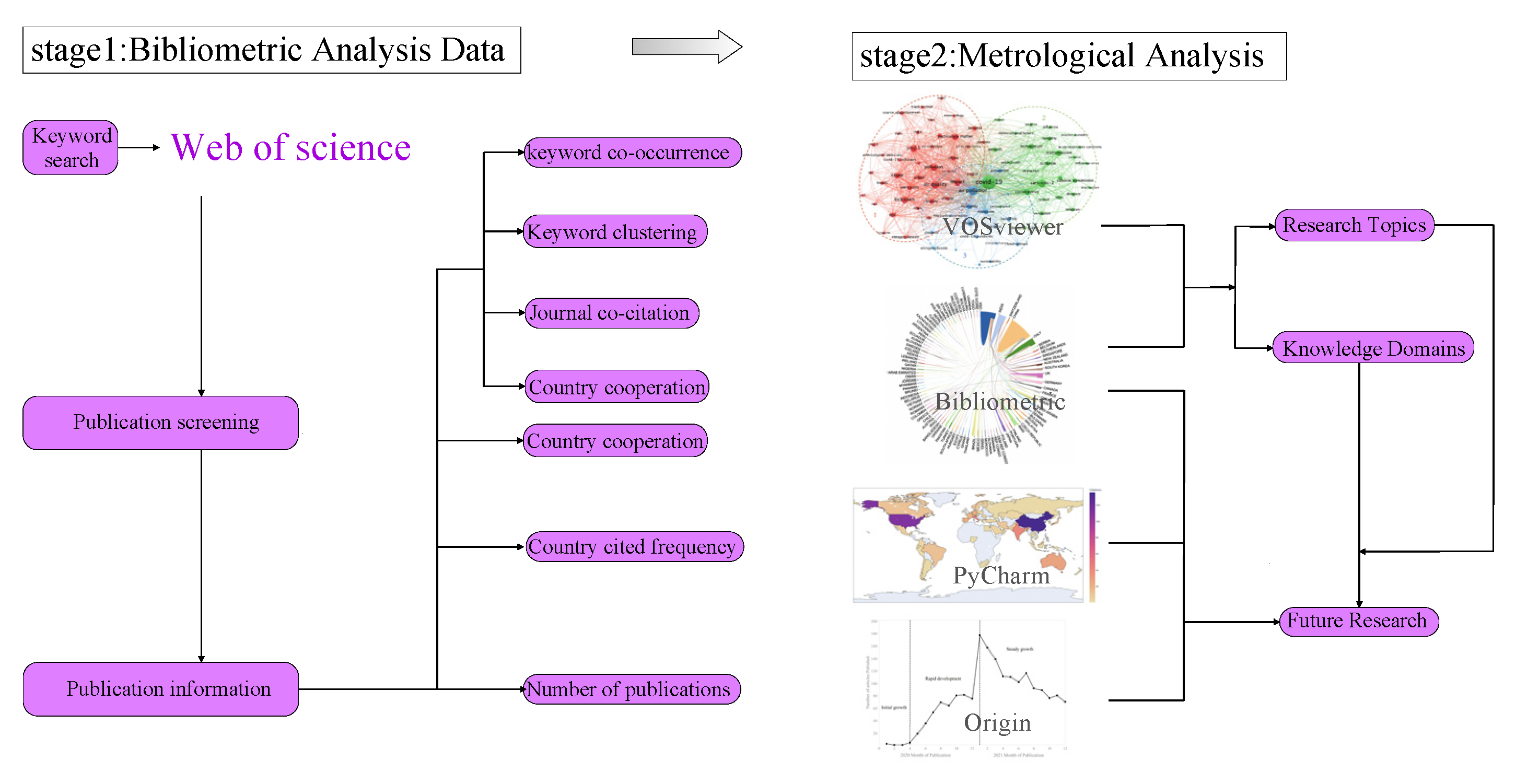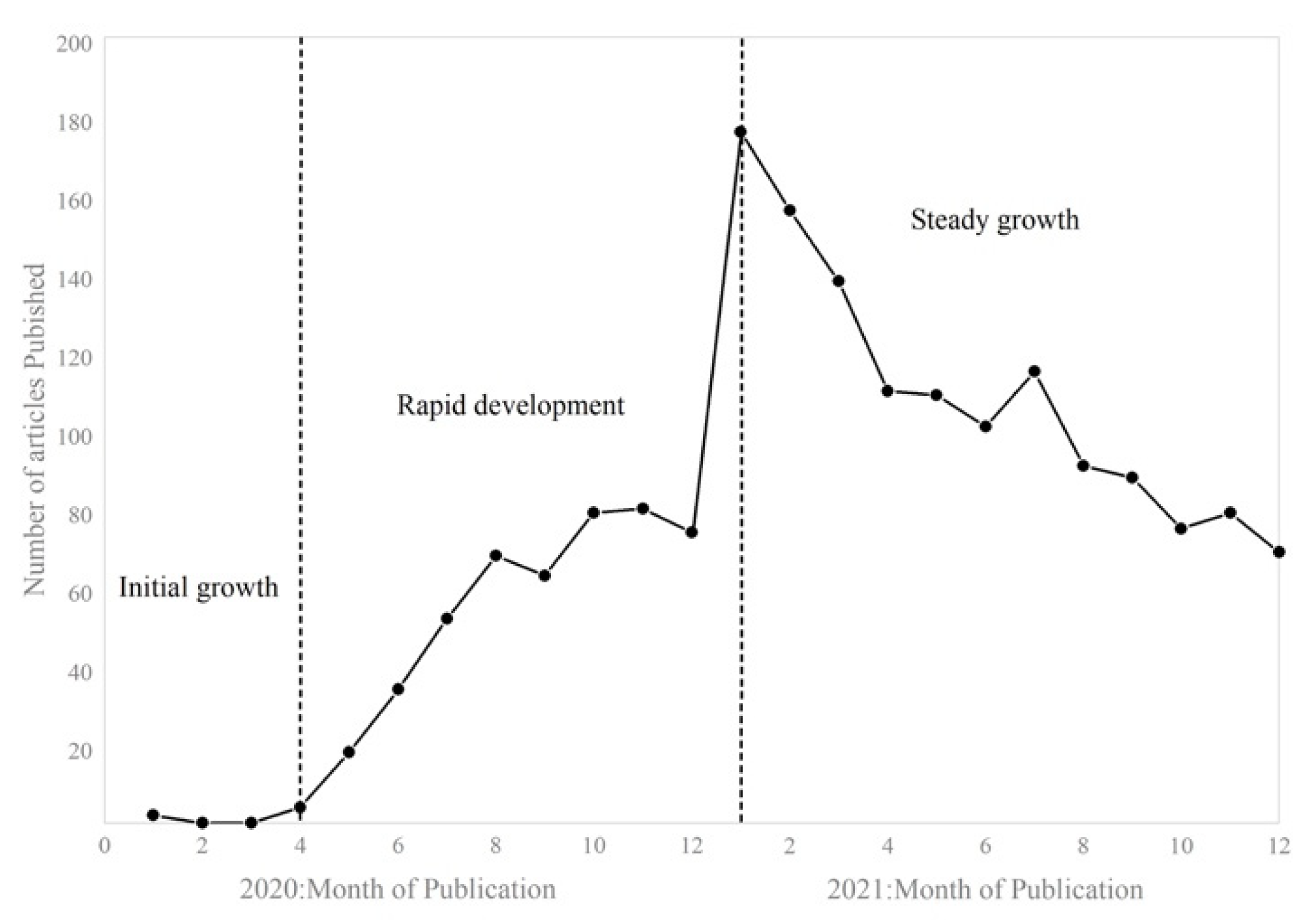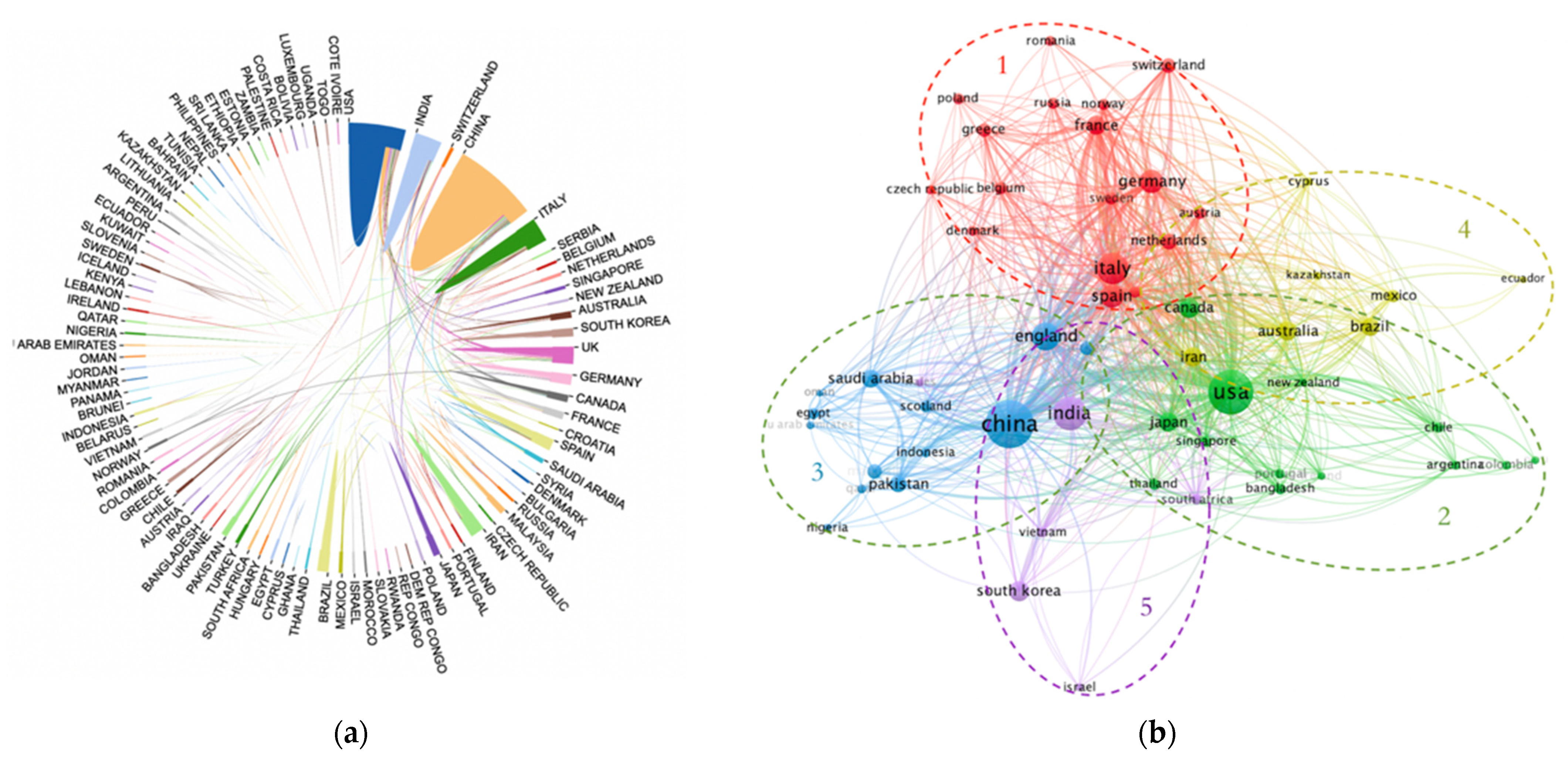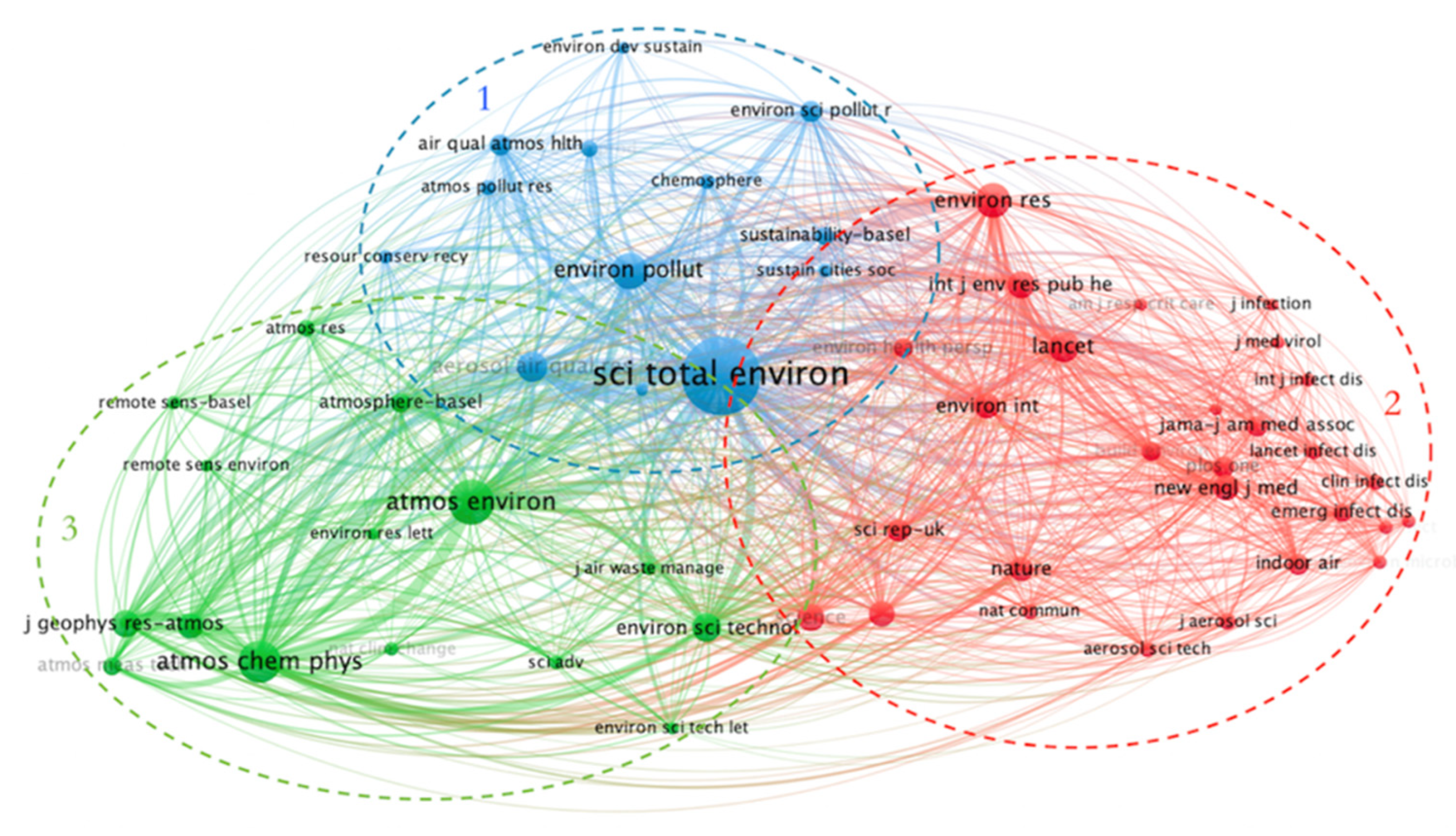The Atmospheric Environment Effects of the COVID-19 Pandemic: A Metrological Study
Abstract
:1. Introduction
2. Research Methodology
2.1. Research Design
2.2. Data Collection
2.3. Data Processing
3. Results of the Metrological Analysis
3.1. The Number of Publications in the Past Two Years
3.2. Influential Authors and Their Research Interests
3.3. Cluster Analysis of National Cooperation
- Construct an association matrix for the analysis object. The co-occurrence matrix based on the quantitative relationship between objects is a data-based square matrix. It is assumed that there are n variables in the research matrix, xij is the co-occurrence observed value of the i-th variable and the j-th variable, and the co-occurrence observed values of all variables form a n × n square matrix [20]. The formula is as follows.
- Calculate the similarity relation value or dissimilarity relation value (distance) between any two data objects in the matrix.
- A certain clustering algorithm is used to divide or merge data objects to form a certain clustering result.
3.4. Country Cited Frequency Analysis
3.5. Analysis of Journal Publications and Co-Citation
3.6. Research Keywords
3.7. Keyword Co-Occurrence Cluster Analysis
- (1)
- Air quality indicators (red) contain keywords “pollution”, “air quality”, “PM2.5”, “ozone”, “lockdown”, “NO2”, “particulate matter”, etc. Cluster 1 focuses on changes in the atmospheric environment and air quality in the context of COVID-19 and describes how lockdowns due to COVID-19 affect air quality.
- (2)
- Meteorological factors affecting the spread of the outbreak (green) contain keywords “COVID-19”, “SARS-CoV-2”, “temperature”, “transmission”, “humidity”, “weather”, etc. Cluster 2 focuses on meteorological factors influencing the spread of COVID-19 and the special relationship between COVID-19 and environmental variables.
- (3)
- Air pollution and human health (blue) contain keywords “air pollution”, “exposure”, “mortality”, “health”, “pandemic”, etc. Cluster 3 focuses on the effects of air pollution on human health and mortality.
3.7.1. COVID-19 and Air Quality
3.7.2. Meteorological Factors Affecting the Spread of COVID-19
3.7.3. Air Pollution and Human Health
4. Conclusions
Author Contributions
Funding
Institutional Review Board Statement
Informed Consent Statement
Data Availability Statement
Conflicts of Interest
References
- Biswal, A.; Singh, T.; Singh, V.; Ravindra, K.; Mor, S. COVID-19 lockdown and its impact on tropospheric NO2 concentrations over India using satellite-based data. Heliyon 2020, 6, e04764. [Google Scholar] [CrossRef]
- Fang, E.Y.; Liu, X.H.; Li, M.; Zhang, Z.L.; Song, L.F.; Zhu, B.Y.; Wu, X.H.; Liu, J.J.; Zhao, D.H.; Li, Y.H. Advances in COVID-19 mRNA vaccine development. Signal Transduct. Tar. 2022, 7, 94. [Google Scholar]
- Fernandes, Q.; Inchakalody, V.P.; Merhi, M.; Mestiri, S.; Taib, N.; El-Ella, D.M.A.; Bedhiafi, T.; Raza, A.; Al-Zaidan, L.; Mohsen, M.O.; et al. Emerging COVID-19 variants and their impact on SARS-CoV-2 diagnosis, therapeutics and vaccines. Ann. Med. 2022, 54, 524–540. [Google Scholar] [CrossRef]
- Zhang, J.D.; Jiang, L.P.; Liu, Z.H.; Li, Y.A.; Liu, K.L.; Fang, R.Y.; Li, H.H.; Qu, Z.G.; Liu, C.Y.; Li, F. A bibliometric and visual analysis of indoor occupation environmental health risks: Development, hotspots and trend directions. J. Clean. Prod. 2021, 300, 126824. [Google Scholar]
- Ye, N.; Kueh, T.B.; Hou, L.S.; Liu, Y.X.; Yu, H. A bibliometric analysis of corporate social responsibility in sustainable development. J. Clean. Prod. 2020, 272, 122679. [Google Scholar] [CrossRef]
- Gou, X.; Liu, H.; Qiang, Y.; Lang, Z.; Wang, H.; Ye, D.; Wang, Z.; Wang, H. In-depth analysis on safety and security research based on system dynamics: A bibliometric mapping approach-based study. Saf. Sci. 2021, 147, 105617. [Google Scholar] [CrossRef]
- Wang, Z.H.; Zhao, Y.D.; Wang, B. A bibliometric analysis of climate change adaptation based on massive research literature data. J. Clean. Prod. 2018, 199, 1072–1082. [Google Scholar] [CrossRef]
- van Eck, N.J.; Waltman, L. Software survey: VOSviewer, a computer program for bibliometric mapping. Scientometrics 2010, 84, 523–538. [Google Scholar] [CrossRef]
- Liu, H.; Hong, R.; Xiang, C.L.; Lv, C.; Li, H.H. Visualization and analysis of mapping knowledge domains for spontaneous combustion studies. Fuel 2020, 262, 13. [Google Scholar] [CrossRef]
- Declementi, M.; Godono, A.; Mansour, I.; Milanesio, N.; Garzaro, G.; Clari, M.; Fedele, L.; Passini, V.; Bongiorno, C.; Pira, E. Assessment of air and surfaces contamination in a COVID-19 non-Intensive Care Unit. Med. Lav. 2020, 111, 372–378. [Google Scholar]
- Ribeiro, S.P.; Silva, A.C.E.; Dattilo, W.; Reis, A.B.; Goes-Neto, A.; Alcantara, L.C.J.; Giovanetti, M.; Coura-Vital, W.; Fernandes, G.W.; Azevedo, V.A.C. Severe airport sanitarian control could slow down the spreading of COVID-19 pandemics in Brazil. Peerj 2020, 8, e9446. [Google Scholar] [CrossRef] [PubMed]
- Zhang, R.X.; Zhang, Y.Z.; Lin, H.P.; Feng, X.; Fu, T.M.; Wang, Y.H. NOx Emission Reduction and Recovery during COVID-19 in East China. Atmosphere 2020, 11, 433. [Google Scholar] [CrossRef]
- Sharma, S.; Zhang, M.Y.; Anshika; Gao, J.S.; Zhang, H.L.; Kota, S.H. Effect of restricted emissions during COVID-19 on air quality in India. Sci. Total Environ. 2020, 728, 8. [Google Scholar] [CrossRef]
- Wang, Y.; Zhu, S.Q.; Ma, J.L.; Shen, J.Y.; Wang, P.F.; Wang, P.; Zhang, H.L. Enhanced atmospheric oxidation capacity and associated ozone increases during COVID-19 lockdown in the Yangtze River Delta. Sci. Total Environ. 2021, 768, 8. [Google Scholar] [CrossRef]
- Zhang, M.Y.; Katiyar, A.; Zhu, S.Q.; Shen, J.Y.; Xia, M.; Ma, J.L.; Kota, S.H.; Wang, P.; Zhang, H.L. Impact of reduced anthropogenic emissions during COVID-19 on air quality in India. Atmos. Chem. Phys. 2021, 21, 4025–4037. [Google Scholar] [CrossRef]
- Ma, J.L.; Shen, J.Y.; Wang, P.; Zhu, S.Q.; Wang, Y.; Wang, P.F.; Wang, G.H.; Chen, J.M.; Zhang, H.L. Modeled changes in source contributions of particulate matter during the COVID-19 pandemic in the Yangtze River Delta, China. Atmos. Chem. Phys. 2021, 21, 7343–7355. [Google Scholar] [CrossRef]
- Kang, M.J.; Zhang, J.; Zhang, H.L.; Ying, Q. On the Relevancy of Observed Ozone Increase during COVID-19 Lockdown to Summertime Ozone and PM2.5 Control Policies in China. Environ. Sci. Technol. Lett. 2021, 8, 289–294. [Google Scholar] [CrossRef]
- Wang, S.Y.; Zhang, Y.L.; Ma, J.L.; Zhu, S.Q.; Shen, J.Y.; Wang, P.; Zhang, H.L. Responses of decline in air pollution and recovery associated with COVID-19 lockdown in the Pearl River Delta. Sci. Total Environ. 2021, 756, 143868. [Google Scholar] [CrossRef]
- Wang, P.F.; Chen, K.Y.; Zhu, S.Q.; Wang, P.; Zhang, H.L. Severe air pollution events not avoided by reduced anthropogenic activities during COVID-19 outbreak. Resour. Conserv. Recycl. 2020, 158, 9. [Google Scholar] [CrossRef]
- Huang, F.; Hou, H.; Liang, G.; Wang, Y.; Hu, Z. Analysis of Clustering Algorithm in Software of Scientometrics. Sci. Technol. Manag. Res. 2018, 38, 232–238. [Google Scholar]
- Waltman, L.; van Eck, N.J.; Noyons, E.C.M. A unified approach to mapping and clustering of bibliometric networks. J. Informetr. 2010, 4, 629–635. [Google Scholar] [CrossRef]
- Yang, Y.F.; Chen, G.H.; Reniers, G.; Goerlandt, F. A bibliometric analysis of process safety research in China: Understanding safety research progress as a basis for making China’s chemical industry more sustainable. J. Clean. Prod. 2020, 263, 121433. [Google Scholar]
- van Eck, N.J.; Waltman, L. Visualizing Bibliometric Networks. In Measuring Scholarly Impact; Springer: Berlin, Germany, 2014; pp. 285–320. [Google Scholar]
- Bamel, U.K.; Pandey, R.; Gupta, A. Safety climate: Systematic literature network analysis of 38 years (1980–2018) of research. Accid. Anal. Prev. 2020, 135, 105387. [Google Scholar] [CrossRef]
- Zou, X.; Yue, W.L.; Vu, H.L. Visualization and analysis of mapping knowledge domain of road safety studies. Accid. Anal. Prev. 2018, 118, 131–145. [Google Scholar] [CrossRef] [PubMed]
- Ho, L.; Alonso, A.; Forio, M.A.E.; Vanclooster, M.; Goethals, P.L.M. Water research in support of the Sustainable Development Goal 6: A case study in Belgium. J. Clean. Prod. 2020, 277, 124082. [Google Scholar] [CrossRef]
- Tao, J.; Qiu, D.Y.; Yang, F.Q.; Duan, Z.P. A bibliometric analysis of human reliability research. J. Clean. Prod. 2020, 260, 11. [Google Scholar] [CrossRef]
- Rume, T.; Didar-Ul Islam, S.M. Environmental effects of COVID-19 pandemic and potential strategies of sustainability. Heliyon 2020, 6, e04965. [Google Scholar]
- Li, L.; Li, Q.; Huang, L.; Wang, Q.; Zhu, A.S.; Xu, J.; Liu, Z.Y.; Li, H.L.; Shi, L.S.; Li, R.; et al. Air quality changes during the COVID-19 lockdown over the Yangtze River Delta Region: An insight into the impact of human activity pattern changes on air pollution variation. Sci. Total Environ. 2020, 732, 11. [Google Scholar] [CrossRef]
- Fasso, A.; Maranzano, P.; Otto, P. Spatiotemporal variable selection and air quality impact assessment of COVID-19 lockdown. Spat. Stat. 2022, 49, 100549. [Google Scholar] [CrossRef]
- Collivignarelli, M.C.; Abba, A.; Bertanza, G.; Pedrazzani, R.; Ricciardi, P.; Miino, M.C. Lockdown for COVID-2019 in Milan: What are the effects on air quality? Sci. Total Environ. 2020, 732, 9. [Google Scholar] [CrossRef]
- Saadat, S.; Rawtani, D.; Hussain, C.M. Environmental perspective of COVID-19. Sci. Total Environ. 2020, 728, 138870. [Google Scholar] [CrossRef]
- He, C.; Hong, S.; Zhang, L.; Mu, H.; Xin, A.X.; Zhou, Y.Q.; Liu, J.K.; Liu, N.J.; Su, Y.M.; Tian, Y.; et al. Global, continental, and national variation in PM2.5, O3, and NO2 concentrations during the early 2020 COVID-19 lockdown. Atmos. Pollut. Res. 2021, 12, 136–145. [Google Scholar] [CrossRef] [PubMed]
- Cheng, K.; Chang, Y.H.; Kuang, Y.Q.; Khan, R.; Zou, Z. Elucidating the responses of highly time-resolved PM2.5 related elements to extreme emission reductions. Environ. Res. 2022, 206, 7. [Google Scholar] [CrossRef]
- Nigam, R.; Pandya, K.; Luis, A.J.; Sengupta, R.; Kotha, M. Positive effects of COVID-19 lockdown on air quality of industrial cities (Ankleshwar and Vapi) of Western India. Sci. Rep. 2021, 11, 12. [Google Scholar] [CrossRef]
- Tibrewal, K.; Venkataraman, C. COVID-19 lockdown closures of emissions sources in India: Lessons for air quality and climate policy. J. Environ. Manage. 2022, 302, 114079. [Google Scholar] [CrossRef]
- Fareed, Z.; Bashir, M.F.; Bilal; Salem, S. Investigating the Co-movement Nexus Between Air Quality, Temperature, and COVID-19 in California: Implications for Public Health. Front. Public Health 2021, 9, 8. [Google Scholar] [CrossRef]
- Ropkins, K.; Tate, J.E. Early observations on the impact of the COVID-19 lockdown on air quality trends across the UK. Sci. Total Environ. 2021, 754, 8. [Google Scholar] [CrossRef]
- Souri, A.H.; Chance, K.; Bak, J.; Nowlan, C.R.; Abad, G.G.; Jung, Y.; Wong, D.C.; Mao, J.Q.; Liu, X. Unraveling pathways of elevated ozone induced by the 2020 lockdown in Europe by an observationally constrained regional model using TROPOMI. Atmos. Chem. Phys. 2021, 21, 18227–18245. [Google Scholar] [CrossRef]
- Torkmahalleh, M.A.; Akhmetvaliyeva, Z.; Omran, A.D.; Omran, F.F.D.; Kazemitabar, M.; Naseri, M.; Naseri, M.; Sharifi, H.; Malekipirbazari, M.; Adotey, E.K.; et al. Global Air Quality and COVID-19 Pandemic: Do We Breathe Cleaner Air? Aerosol Air Qual. Res. 2021, 21, 200567. [Google Scholar] [CrossRef]
- Ching, J.; Kajino, M. Rethinking Air Quality and Climate Change after COVID-19. Int. J. Environ. Res. Public Health 2020, 17, 5167. [Google Scholar] [CrossRef]
- Sarwar, S.; Shahzad, K.; Fareed, Z.; Shahzad, U. A study on the effects of meteorological and climatic factors on the COVID-19 spread in Canada during 2020. J. Environ. Health Sci. Eng. 2021, 19, 1513–1521. [Google Scholar] [CrossRef] [PubMed]
- Shahzad, K.; Farooq, T.H.; Dogan, B.; Hu, L.Z.; Shahzad, U. Does environmental quality and weather induce COVID-19: Case study of Istanbul, Turkey. Environ. Forensics 2021. [Google Scholar] [CrossRef]
- Fareed, Z.; Iqbal, N.; Shahzad, F.; Shah, S.G.M.; Zulfiqar, B.; Shahzad, K.; Hashmi, S.H.; Shahzad, U. Co-variance nexus between COVID-19 mortality, humidity, and air quality index in Wuhan, China: New insights from partial and multiple wavelet coherence. Air Qual. Atmos. Health 2020, 13, 673–682. [Google Scholar] [CrossRef] [PubMed]
- Bashir, M.F.; Benghoul, M.; Numan, U.; Shakoor, A.; Komal, B.; Bashir, M.A.; Bashir, M.; Tan, D.J. Environmental pollution and COVID-19 outbreak: Insights from Germany. Air Qual. Atmos. Health 2020, 13, 1385–1394. [Google Scholar] [CrossRef]
- Linares, C.; Belda, F.; Lopez-Bueno, J.A.; Luna, M.Y.; Sanchez-Martinez, G.; Hervella, B.; Culqui, D.; Diaz, J. Short-term associations of air pollution and meteorological variables on the incidence and severity of COVID-19 in Madrid (Spain): A time series study. Environ. Sci. Eur. 2021, 33, 1–13. [Google Scholar] [CrossRef]
- Barcellos, D.D.; Fernandes, G.M.K.; de Souza, F.T. Data based model for predicting COVID-19 morbidity and mortality in metropolis. Sci. Rep. 2021, 11, 24491. [Google Scholar] [CrossRef]
- Coccia, M. How do low wind speeds and high levels of air pollution support the spread of COVID-19? Atmos. Pollut. Res. 2021, 12, 437–445. [Google Scholar] [CrossRef]
- Conticini, E.; Frediani, B.; Caro, D. Can atmospheric pollution be considered a co-factor in extremely high level of SARS-CoV-2 lethality in Northern Italy? Environ. Pollut. 2020, 261, 3. [Google Scholar] [CrossRef]
- Meo, S.A.; Alqahtani, S.A.; Binmeather, F.S.; AlRasheed, R.A.; Aljedaie, G.M.; Albarrak, R.M. Effect of environmental pollutants PM2.5, CO, O3 and NO2, on the incidence and mortality of SARS-CoV-2 in largest metropolitan cities, Delhi, Mumbai and Kolkata, India. J. King Saud Univ. Sci. 2022, 34, 101687. [Google Scholar] [CrossRef]
- Aggarwal, S.; Balaji, S.; Singh, T.; Menon, G.R.; Mandal, S.; Madhumathi, J.; Mahajan, N.; Kohli, S.; Kaur, J.; Singh, H.; et al. Association between ambient air pollutants and meteorological factors with SARS-CoV-2 transmission and mortality in India: An exploratory study. Environ. Health 2021, 20, 120. [Google Scholar] [CrossRef]
- Faridi, S.; Yousefian, F.; Niazi, S.; Ghalhari, M.R.; Hassanvand, M.S.; Naddafi, K. Impact of SARS-CoV-2 on Ambient Air Particulate Matter in Tehran. Aerosol Air Qual. Res. 2020, 20, 1805–1811. [Google Scholar] [CrossRef]
- Fattorini, D.; Regoli, F. Role of the chronic air pollution levels in the COVID-19 outbreak risk in Italy. Environ. Pollut. 2020, 264, 5. [Google Scholar] [CrossRef]
- Wen, C.; Akram, R.; Irfan, M.; Iqbal, W.; Dagar, V.; Acevedo-Duqued, A.; Saydaliev, H.B. The asymmetric nexus between air pollution and COVID-19: Evidence from a non-linear panel autoregressive distributed lag model. Environ. Res. 2022, 209, 112848. [Google Scholar] [CrossRef] [PubMed]
- Meo, S.A.; Almutairi, F.J.; Abukhalaf, A.A.; Usmani, A.M. Effect of Green Space Environment on Air Pollutants PM2.5, PM10, CO, O3, and Incidence and Mortality of SARS-CoV-2 in Highly Green and Less-Green Countries. Int. J. Environ. Res. Public Health 2021, 18, 13151. [Google Scholar] [CrossRef]







| Rank | Author | Institution | TP | TC | AC | Main Research Interests |
|---|---|---|---|---|---|---|
| 1 | Zhang, Hongliang | Fudan University | 7 | 852 | 121.7 | The impact of lockdown measures on air quality in China and India |
| 2 | Coccia, Mario | CNR Natl Res Council Italy | 6 | 558 | 93 | The impact of air pollution on the spread of outbreaks |
| 3 | Bashir, Muhammad Farhan | Cent South University | 6 | 539 | 89.8 | Environmental quality, climate indicators and the COVID-19 pandemic |
| 4 | Querol, Xavier | Spanish Res Council CSIC | 5 | 423 | 84.6 | Changes in air quality caused by COVID-19 lockdown and its implications |
| 5 | Wang, Peng | Hong Kong Polytech University | 7 | 358 | 51.1 | Changes and causes of air pollutant concentration under epidemic lockdown |
| Rank | Journal Title | TP | TP (%) | TC | IF (2021) | Subject Category of the Journal |
|---|---|---|---|---|---|---|
| 1 | Science of The Total Environment | 203 | 11.39% | 12,176 | 10.753 | Environmental Sciences |
| 2 | International Journal of Environmental Research and Public Health | 140 | 7.86% | 1368 | 4.614 | Public Environmental & Occupational Health |
| 3 | Environmental Research | 134 | 7.52% | 2323 | 8.431 | Environmental Sciences |
| 4 | Aerosol and Air Quality Research | 125 | 7.02% | 1384 | 4.53 | Environmental Sciences |
| 5 | Sustainability | 109 | 6.12% | 542 | 3.889 | Green & Sustainable Science & technology |
| 6 | Environmental Science and Pollution Research | 89 | 5.00% | 565 | 5.190 | Environmental Sciences |
| 7 | Atmosphere | 81 | 4.55% | 466 | 3.110 | Meteorology & Atmospheric Sciences |
| 8 | Scientific Reports | 75 | 4.21% | 832 | 4.996 | Multidisciplinary Sciences |
| 9 | Environmental Pollution | 60 | 3.37% | 1644 | 9.988 | Environmental Sciences |
| 10 | Air Quality Atmosphere and Health | 55 | 3.09% | 1115 | 5.804 | Environmental Sciences |
Publisher’s Note: MDPI stays neutral with regard to jurisdictional claims in published maps and institutional affiliations. |
© 2022 by the authors. Licensee MDPI, Basel, Switzerland. This article is an open access article distributed under the terms and conditions of the Creative Commons Attribution (CC BY) license (https://creativecommons.org/licenses/by/4.0/).
Share and Cite
Chen, Z.; Shi, D. The Atmospheric Environment Effects of the COVID-19 Pandemic: A Metrological Study. Int. J. Environ. Res. Public Health 2022, 19, 11111. https://doi.org/10.3390/ijerph191711111
Chen Z, Shi D. The Atmospheric Environment Effects of the COVID-19 Pandemic: A Metrological Study. International Journal of Environmental Research and Public Health. 2022; 19(17):11111. https://doi.org/10.3390/ijerph191711111
Chicago/Turabian StyleChen, Zhong, and Dongping Shi. 2022. "The Atmospheric Environment Effects of the COVID-19 Pandemic: A Metrological Study" International Journal of Environmental Research and Public Health 19, no. 17: 11111. https://doi.org/10.3390/ijerph191711111
APA StyleChen, Z., & Shi, D. (2022). The Atmospheric Environment Effects of the COVID-19 Pandemic: A Metrological Study. International Journal of Environmental Research and Public Health, 19(17), 11111. https://doi.org/10.3390/ijerph191711111







